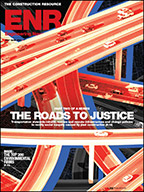
Shanghai's Greenland Group has become one of the world's largest property developers, with nearly $6 billion in North American projects proposed or under construction. Major contractors such as San Francisco-based Webcor Builders are now at work on sites developed by Greenland Group and its partners. The projects include the $1.4-billion Metropolis project in Los Angeles and the $5-billion Atlantic Yards project in New York City. On the latter project, Greenland is partners with a big U.S. developer, Forest City.
There is no sign that any Greenland project has financial trouble, yet a mounting company debt load equal to 70% of the developer's overall capitalization is a focus for analysts watching Greenland's risk profile. Debt-rating firm Moody's says Greenland's 70% to 75% debt leverage and near-term earnings-interest ratio has produced a tight margin for the company to meet analyst expectations—and any variance could result in a lower credit rating and higher borrowing costs.
More broadly, China's vaunted economic expansion is slowing and its domestic real estate is considered overpriced. Looking for greener pastures, the Chinese are building in North America like never before.
"They want to get their money out of China," says Gordon Hunt, a Pasadena, Calif.-based construction attorney and former chairman of the legal advisory committee for the Associated General Contractors of California. "And they think the U.S. is the best place to put it."
Lenders and bond investors have skin in the game. Fitch Ratings reports that 14 Chinese banks have a $3.3-trillion exposure to property; if prices fall, there could be problems servicing debt. Chinese developers currently have $66 billion in offshore bonds outstanding, said research firm Dealogic.
Because U.S. construction firms may not be familiar with the companies backing the projects, one of the most important details in a risk analysis involves determining who the owner actually is, Hunt says. "There could be three or four layers to a company before you get to the people with the money, so contractors should be concerned with knowing the entity actually has assets."
On that note, Greenland issued $2.7 billion in bonds last year, when the Chinese government approved a new debt structure that allowed onshore companies to back offshore subsidiaries in financing deals with foreign investors. But "a subsidiary can have little or no assets," Hunt says.
Because highly leveraged projects may create risk for contractors, firms should always negotiate with foreign companies to include payment guarantees or other security provisions. Dev Strischek, a construction analyst with Sun Trust Bank, says that pursuing a claim against a Chinese company could be very difficult in the event of a default.


Post a comment to this article
Report Abusive Comment